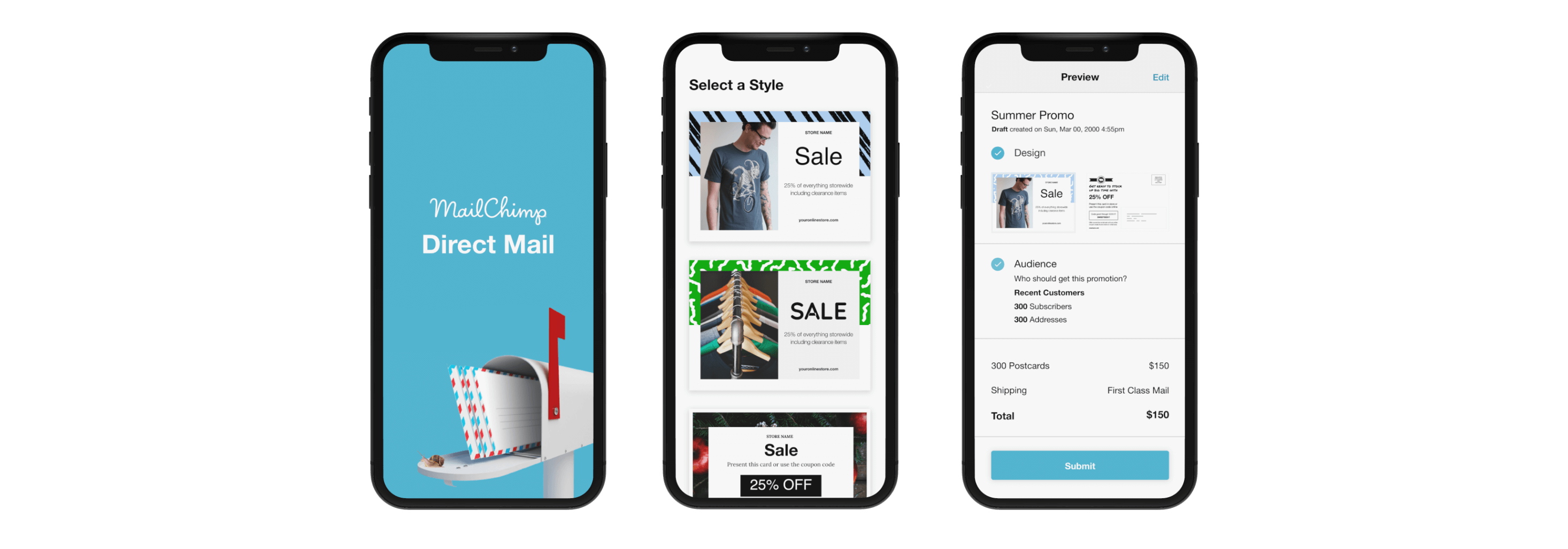transactional email (2013)
Kicking off a longterm partnership in innovation


“Our ongoing relationship with Digital Scientists is critical to my efforts at Mailchimp – as we explore new experiences and technologies for our customers. Their team’s maturity and ability to deliver while thinking deeply about complex problems helps us gain valuable perspective of what’s possible.”
CHRIS BEAUREGARD
director of product management @ mailchimpMailchimp is currently the largest email marketing platform in the world, with 16 million active customers. When Mailchimp launched its email services 20 years ago, its strategy was simple. To make email marketing fun and easy. But by 2013, fun and easy wasn’t enough. To fend off encroaching competition, Mailchimp needed to supercharge its innovation efforts. That’s where we came in.
Working closely with Mailchimp’s chief product officer, we helped fuel the company’s innovation pipeline by leveraging our expertise in product development, UX design, AI & machine learning, helping to propel Mailchimp from a basic email marketing service to the all-in-one platform it is today. Here’s what we brought to the chimp tribe to help it become a global leader in all-in-one marketing solutions:
transactional email (2013)
Kicking off a longterm partnership in innovation

Our partnership with Mailchimp began with market research for Mandrill, a transactional email service that delivers fast, personalized transactional emails across a globally distributed infrastructure.
Leveraging our R&D team, we performed market research and provided strategy on market segmentation, brand architecture, and product development – all with a focus on speed, reliability, and global distribution.
From this initial engagement, our relationship with Mailchimp took off into what would become a long-term partnership in innovation.
At the completion of the Mandrill engagement, Mailchimp hired us to develop a program that could help Mailchimp subscribers gain deeper insights into their customers’ behavior. How could Mailchimp’s user base of small business owners learn more about their customers’ preferences? If Mailchimp users could gain a deeper understanding of their customers’ needs, they could provide a more personalized user experience.
At the completion of the Mandrill engagement, Mailchimp hired us to develop a program that could help Mailchimp subscribers gain deeper insights into their customers’ behavior. How could Mailchimp’s user base of small business owners learn more about their customers’ preferences? If Mailchimp users could gain a deeper understanding of their customers’ needs, they could provide a more personalized user experience.
To monitor activity across multiple platforms, our development team created a RubyGem that could track and store data on customer activity, including open and click rates, website visits, and return visits. Through an activity tracker, Mailchimp users could now gain a deeper understanding of their customers’ needs, which in turn could help them generate targeted personalized content, including:
pop-up shop (2017)
Between 2015-17, Mailchimp began to experience explosive growth. While the product team was under pressure to continue operating and scaling product, they also were tasked with driving innovation. Among the many ideas bubbling up from the product team was the question, “Is it possible to sell products via email?” Yes, it’s possible, and we could help make it happen. The result was Pop-Up Shop, a new service that would enable an amateur seller to create their own ecommerce page quickly and easily on either their desktop or mobile device.

Enable a business owner to create an ecommerce page that will help them sell a product insanely fast with as few clicks as possible, via email. Think “Buy it Now,” with all the features provided in a standard ecommerce platform:
To help a user build an ecommerce page, we needed to empower that user with the tools necessary to build a page with confidence. How can we simplify the process and reduce the number of required clicks to just five or six?
Through extensive research and competitive analysis, we were able to examine patterns and distill down how other ecommerce players at the time were accomplishing these goals, and the most effective way to optimize that job. By providing users with easily uploadable content and preset themes and templates, we were able to pack a lot of power into a few keystrokes – ideal for novice marketers and folks creating ecommerce pages on the fly.
Within 90 days, our team at Digital Scientists was able to provide Mailchimp with the foundation and proof-of-concept for Mailchimp’s Pop-Up Shop, the predecessor to its current offering, Shoppable Landing Pages.
Over the years, Mailchimp and Digital Scientists have collaborated on some of the most innovative technology in email marketing, including Direct Mail Postcards, an app that enables Mailchimp subscribers to easily design and send printed postcards to their customers. Sounds retro? You bet. Mailchimp was seeking an optional way for its users to connect with their customers and to reinforce online messaging with something tangible and memorable. Postcards give users a way to share promo codes, announce an event, recover abandoned carts, or just say thank you with a personal touch.

Enable a business owner to create an ecommerce page that will help them sell a product insanely fast with as few clicks as possible, via email. Think “Buy it Now,” with all the features provided in a standard ecommerce platform:
Our research team kicked off this project with a competitive analysis of other direct mail and ecommerce platforms, searching for patterns and identifying strengths and weaknesses of potential competitors. From there, we partnered with a printing house, ran several trials to determine output, and explored how to build the printing integration. Meanwhile, our designers created a selection of default templates that Mailchimp users could easily customize for their contacts. The final prototype was a polished and intuitive experience for the design and delivery process.
With the continuing expansion of ecommerce, small business owners increasingly were looking to one-stop shops, seeking options that would allow them to build landing pages using their own campaign assets. Pop-Up Shop, which we’d developed earlier that year for Mailchimp, was its answer to that need and a precursor to what would become its new expanded offering, Shoppable, Sales & Ecommerce Landing Pages.
Design a CMS tool, inside the current MailChimp experience that would let Mailchimp subscribers easily create their own landing pages to promote an offer, test the market, or sell a product.
As with every project, we deployed our research team to perform a competitive analysis, reviewing patterns, templates, widgets, and other features offered by landing page providers and website builders. Next, we created user personas, identified use cases, and began journey mapping.
From there, we pulled in our DS designers and developers to identify feature specifications and begin building the design for a clickable prototype.
website builder (2018)
As landing pages gained traction in the Mailchimp community, a question emerged, Why stop at a landing page? What if we could empower users to build a larger, more fully featured website within the Mailchimp platform? To explore that opportunity, we began rethinking the editing experience, bouncing around some novel ideas for desktop and mobile editing.

Push the boundaries of the Mailchimp user interface to allow users to reserve a domain, build a website, and grow and manage their audience all in one place.
As a first step, we deployed our research team to perform a competitive analysis, uncovering patterns to help inform a path forward. After a deep dive into the competitive landscape, we surveyed small business owners about their own experiences – how they use their sites, their pain points, wish lists, etc. From there, we created user personas, identified use cases, and began journey mapping. Once we had a clear vision of our audience, the user journey, and a set of desired features, we began building a clickable prototype.

internationalization (2020)
As a global leader in email marketing, Mailchimp reaches 178 countries, in 50 different languages. That’s a lot of translation. To expand its reach and service to people throughout the world, Mailchimp needed to enable its marketing site and Knowledge Base for translation.
Enable localization of Mailchimp’s Contentful environment.
To enable localization of Mailchimp’s front-facing marketing site, we designed and developed a language selection dropdown and cookies experience, as well as engineered and deployed a content migration script that enabled translations in Mailchimp’s Contentful environment.
In February 2019, Mailchimp acquired a company that had recently built a design platform that could help marketing professionals instantly develop branded designs for social media channels. The platform would enable users to upload their brand assets, such as logo, colors, and photos, and would automatically generate pre-designed marketing material in the user’s brand.
But one obstacle impeded the automation process for platform users – the human element. Marketers were quick to sign on to the design service, but slow to build and upload their brand profiles. Mailchimp engaged Digital Scientists to integrate and improve the service in a way that would assist its customers with branded design material as quickly as possible.

Automate the process of gathering brand and campaign assets, with minimal user input.
Working closely with Mailchimp and the product visionary, our team of engineers developed a tool called Site Analyzer – an AI-powered feature that can automatically detect, analyze, and classify brand and campaign content from a user’s site.
Site Analyzer uses machine learning to automatically learn and understand a user’s website, analyzing a website for logo, colors, fonts, and relevant campaign content – all in an instant.
Have a project in mind?